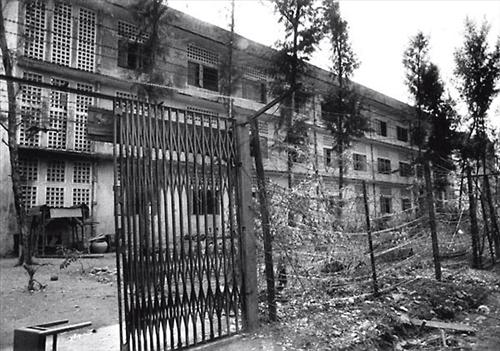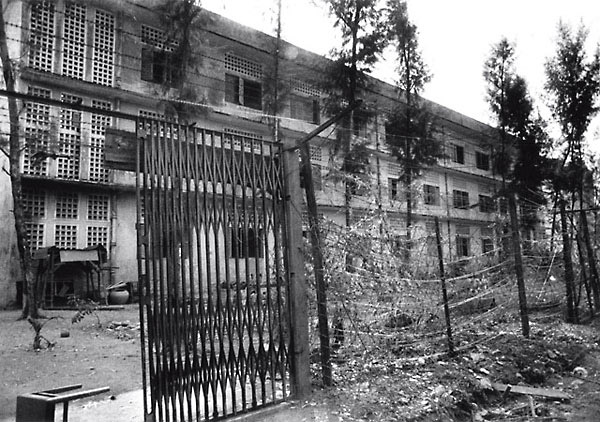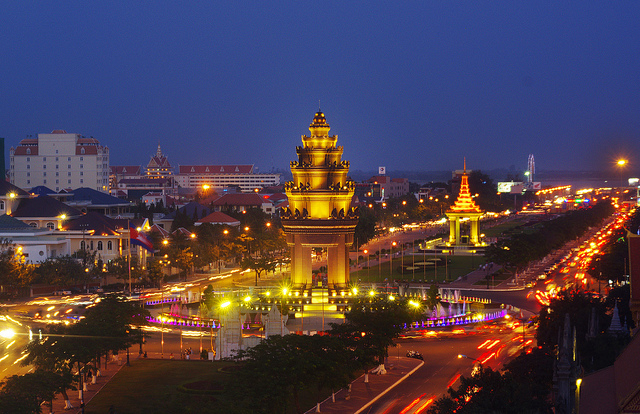
School - prison
Toulsleng Remnants Museum is located in the center of Phnom Penh city. Right next to the street is a bustling life that changes day and night, but when you step in here, you feel a creepy feeling, time seems to stop. Before the genocide, this place was a school with three U-shaped buildings embracing the school yard with ancient trees providing cool shade. People think of children, wearing uniforms, carrying school bags on their shoulders, dancing and singing carefreely. But then, as if from the sky, there were cold shouts, the shrill sound of bullets being loaded, and innocent people falling.

A corner of Toulsleng Remnants Museum in the center of Phnom Penh city (Photo: me.zing)
The first row of buildings in this museum was the prison for Cambodian revolutionary cadres. When the Cambodian army and Vietnamese volunteer troops invaded and liberated this place, Pol Pot’s army had just executed 14 Cambodian cadres whom they considered dangerous elements. Each cell held one person, had an iron bed, and they forced the prisoner to lie on it and locked it with an iron lock.
The next row of houses was the detention area for those whom Pol Pot suspected of opposing them. This area sometimes held thousands of people. The outer railings were so tightly woven with barbed wire that even a chicken could not get through. With the policy of “better to catch the wrong person than to let someone go”, regardless of age, gender, anyone who showed signs of suspicion was arrested or shot on the spot.
In the last row of houses is where they tortured and abused prisoners. The images that simulated their torture were brutal. They did everything they could to cause extreme, persistent pain. They twisted their limbs behind their backs, tied them up, carried them up, and beat them like animals. Then there was the terrifying scene of forcing the prisoner to jump from top to bottom right onto the sharp sword below, etc. Another extremely brutal and haunting scene was the image of the wife of Mr. Kuy Thuon - the minister of commerce at that time, having to endure the torture of having an iron drill drilled into her head. The drill slowly went in, causing horror, simply because they thought the minister was a capitalist, an enemy they considered to be an enemy that had to be destroyed.
Oh Vietnam!

Two brothers Norng Chan Phal and Norng Chan Li were saved from genocide by Vietnamese volunteer soldiers (Photo: tuoitre.vn)
The first Cambodian we spoke to was Norng Chan Phal. When the group was starting to listen to the tour guide named Thach Da Ra introduce himself, a middle-aged man came up and asked permission to say something. After receiving permission from the group leader, he clasped his hands in front of his chest according to Cambodian custom and said: Let me thank the Vietnamese people, thank the Vietnamese volunteer army for saving us from death, from genocide. He pointed to a large billboard with a picture of the Cambodian army and Vietnamese volunteer army saving children. Two of the children with no clothes on were Norng Chan Phal and his younger brother Norng Chan Li. Thirty-five years have passed, but Norng Chan Phal cannot forget that rare moment when he escaped death and was able to live. And a lucky thing happened to him: his younger brother Norng Chan Li also escaped genocide thanks to the protection of the Vietnamese volunteer army. Mr. Thach Da Ra said that Mr. Norng Chan Phal is currently married, with a wife and two children. He works as an employee at this museum. Every time a delegation from Vietnam comes to visit or work, he asks to meet them to say a sincere and grateful sentence: Thank you Vietnam, thank you Vietnamese volunteer soldiers!

Cambodia today: streets of the capital Phnom Penh at night/Photo: worldtravel-tour.com
Epilogue
War is like that. The ultimate evil between people, between fellow human beings, between the same blood, the same clan. When there is no more love for one's fellow human beings, when evil is so insane that it disregards everything, its actions are more than animalistic. I don't know how many killing fields there are in this country of over one hundred thousand square kilometers, how many prison camps like Toulsleng, how many crowded burial pits.
Cambodia has been liberated, escaped the genocide. Now Cambodia is on the path of innovation and development. Her smile is as bright as the Ph'ca colap flower (rose), as gentle as the Apsara dance, touching people's hearts. They want to forget what the entire Cambodian people have gone through, had to endure. There is one thing they do not forget, never forget and it is very simple: "O Cun Vietnam, O Cun Vietnamese volunteer army!"(Thank you Vietnam, thank you Vietnamese volunteer soldiers!).
Author:Pham Dinh Lan
Newer news
Older news